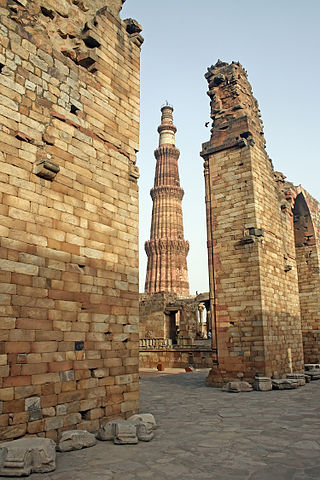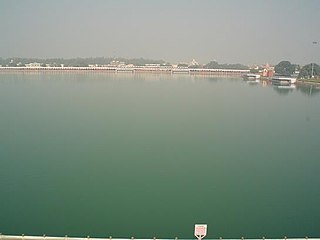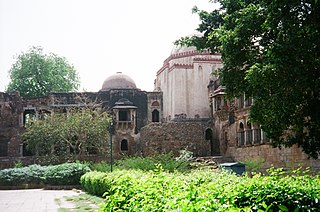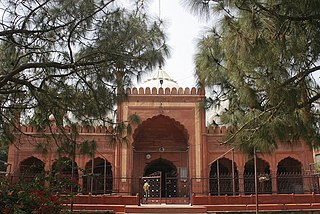
Jahanara Begum was a Mughal princess and later the Padshah Begum of the Mughal Empire from 1631 to 1658 and again from 1668 until her death. She was the second and the eldest surviving child of Emperor Shah Jahan and Mumtaz Mahal.

The Qutb Minar complex are monuments and buildings from the Delhi Sultanate at Mehrauli in Delhi, India. Construction of the Qutub Minar "victory tower" in the complex, named after the religious figure Sufi Saint Khwaja Qutbuddin Bakhtiar Kaki, was begun by Qutb-ud-din Aibak, who later became the first Sultan of Delhi of the Mamluk dynasty. It was continued by his successor Iltutmish, and finally completed much later by Firoz Shah Tughlaq, a Sultan of Delhi from the Tughlaq dynasty (1320–1412) in 1368 AD. The Qubbat-ul-Islam Mosque, later corrupted into Quwwat-ul Islam, stands next to the Qutb Minar.

Dara Shikoh, also known as Dara Shukoh, was the eldest son and heir-apparent of the Mughal emperor Shah Jahan. Dara was designated with the title Padshahzada-i-Buzurg Martaba and was favoured as a successor by his father and his elder sister, Princess Jahanara Begum. He had been given the title of 'Sultan Buland Iqbal' by Shah Jahan. In the war of succession which ensued after Shah Jahan's illness in 1657, Dara was defeated by his younger brother Prince Muhiuddin. He was executed in 1659 on Aurangzeb's orders in a bitter struggle for the imperial throne.

Humayun's tomb is the tomb of Mughal emperor, Mirza Nasir al-Din Muhammad commonly known as Humayun situated in Delhi, India. The tomb was commissioned by Humayun's first wife and chief consort, Empress Bega Begum under her patronage in 1558, and designed by Mirak Mirza Ghiyas and his son, Sayyid Muhammad, Persian architects chosen by her. It was the first garden-tomb on the Indian subcontinent, and is located in Nizamuddin East, Delhi, close to the Dina-panah Citadel, also known as Purana Qila, that Humayun found in 1538. It was also the first structure to use red sandstone at such a scale. The tomb was declared a UNESCO World Heritage Site in 1993, and since then has undergone extensive restoration work, which is complete. Besides the main tomb enclosure of Humayun, several smaller monuments dot the pathway leading up to it, from the main entrance in the West, including one that even pre-dates the main tomb itself, by twenty years; it is the tomb complex of Isa Khan Niazi, an Afghan noble in Sher Shah Suri's court of the Suri dynasty, who fought against the Mughals, constructed in 1547 CE.

Mehrauli is a neighbourhood in South Delhi, Delhi, India. It represents a constituency in the legislative assembly of Delhi. The area is close to Gurugram and next to Vasant Kunj.
Sarai Kale Khan is a village in South East Delhi district in Delhi. This is a Gurjar village of clan Basista/Bosatta. This place is remotely connected to other parts of Delhi through the means of Delhi Metro Pink Line. It also has Inter-State Bus Terminus. It is adjacent to the Hazrat Nizamuddin Railway Station. It is one of the five main stations in Delhi and is the originating and terminal station for 60 trains. Sarai Kale Khan is the terminus for most buses heading for towns south of Delhi. It is also a DTC bus depot for the Mudrika Seva and many other bus routes.

The Qadiriyya are members of the Sunni Qadiri tariqa. The tariqa got its name from Abdul Qadir Gilani, who was a Hanbali scholar from Gilan, Iran. The order relies strongly upon adherence to the fundamentals of Sunni Islamic law.

Thanesar is a historic city and Hindu pilgrimage centre in the Kurukshetra district of Haryana, India. It is located approximately 160 km northwest of Delhi. The city Kurukshetra's area merges with Thanesar.

Kurukshetra is a city and administrative headquarters of Kurukshetra district in the Indian state of Haryana. It is also known as Dharmakshetra and as the "Land of the Bhagavad Gita".

Hauz Khas Complex in Hauz Khas, South Delhi houses a water tank, an Islamic seminary, a mosque, a tomb, and pavilions built around an urbanized village with medieval history traced to the 13th century of Delhi Sultanate reign. It was part of Siri, the second medieval city of India of the Delhi Sultanate of Alauddin Khalji Dynasty (1296–1316). The etymology of the name Hauz Khas in Persian is derived from the words ‘Hauz’: "water tank" and ‘Khas’:"royal"- the "Royal tank". The large water tank or reservoir was first built by Allauddin Khilji to supply water to the inhabitants of Siri. The tank was de–silted during the reign of Firuz Shah Tughlaq (1351–88). Several buildings and tombs were built overlooking the water tank or lake. Firuz Shah's tomb pivots the L–shaped building complex which overlooks the tank.

Kurukshetra district is one of the 22 districts of Haryana state in northern India. The town of Kurukshetra, a sacred place for the Hindus, is the administrative headquarters of this district. The district occupies an area of 1530.00 km². The district has a population of 964,655. This district is part of Ambala division. Kurukshetra is also the land of Srimad Bhagawad Gita. Jyotisar is the place in Kurukshetra where Krishna is believed to deliver the sermon of Gita to Arjuna in the Mahabharata.
Bhagwanpura, also known as Baghpur, is a village in Kurukshetra district, Haryana, India. It is an archaeological site that lies on the bank of Hakra Ghaggar channel. Situated 24 km northeast of Kurukshetra, the site is notable for showing an overlap between the late Harappan and Painted Grey Ware cultures. Painted Grey Ware is generally associated with the Vedic people, so this area can be said as the junction of two great civilizations of India.
Tourism in Haryana relates to tourism in the state of Haryana, India. There are 21 tourism hubs created by Haryana Tourism Corporation (HTC), which are located in Ambala, Bhiwani Faridabad, Fatehabad, Gurgaon, Hisar, Jhajjar, Jind, Kaithal, Karnal, Kurukshetra, Panchkula, Sirsa, Sonipat, Panipat, Rewari, Rohtak, Yamunanagar, Palwal and Mahendergarh.
Sufi Saint Abdul-Karim Abd-ur-Razak; popularly known by the name of Sheikh Chilli, was a Qadiriyya Sufi, he was known for his wisdom and generosity. He was the master of Mughal Prince Dara Shikoh. Many people consider him a great darwesh. There is a Sheikh Chilli's Tomb located in Thanesar, Haryana, India, in Kurukshetra.
Sheikh Chilli may refer to:
Haryana State Directorate of Archaeology & Museums is a ministry and department of the Government of Haryana in India.
The Bodh Stupa is situated near the Fine Arts Department in the north-east region of Kurukshetra University, in Haryana, 160 km from Delhi, India.
Pathar Masjid (Thanesar) is a mosque build of red sandstone in Mughal architecture style. The fluted minarets are attached to the back walls. Believed to be built in 17th century, the mosque is located in Thanesar and is protected by the Government of India. The ceiling that rests on pillars is decorated by carved floral designs. It is situated near the tomb of Sheikh Chilli.
The archaeological excavations located on the outskirts of the city of Kurukshetra. Kurukshetra, District : Kurukshetra, Adjacent to Sheikh Chilli's Tomb, Excavation revealed antiquities from first millennium BCE to 19th century related to Vedic & Late Vedic periods, and at least six other subsequent cultural and historical periods. Site was abandoned after the vedic period in the first millennium BCE, then continuously habited from 1st century CE to 19th century. The site, spread over an area of 1 km x750 m x 23 m, containts historical remnants belonging to vedic as well as six continuously habited post-vedic periods ranging from Kushan to Mughal era.

Madrasa Ghaziuddin Khan is a historical madrasa complex located by the Ajmeri Gate in Old Delhi, India. It was founded around the 18th century by Ghaziuddin Khan I, a leading noble of the Mughal empire. Following the discontinuation of its original function as a madrasa, it successively housed colonial-era educational institutions, such as Delhi College and the Anglo-Arabic school. Today, the Zakir Husain Delhi College operates in its premises, making the madrasa the oldest continuing educational centre in the city of Delhi.


























